
The Soviet Navy was the naval warfare uniform service branch of the Soviet Armed Forces. Often referred to as the Red Fleet, the Soviet Navy made up a large part of the Soviet Union's strategic planning in the event of a conflict with the opposing superpower, the United States, during the Cold War (1945–1991). The Soviet Navy played a large role during the Cold War, either confronting the North Atlantic Treaty Organization in western Europe or power projection to maintain its sphere of influence in eastern Europe.

The Echo class were nuclear cruise missile submarines of the Soviet Navy built during the 1960s. Their Soviet designation was Project 659 for the first five vessels, and Project 675 for the following twenty-nine. Their NATO reporting names were Echo I and Echo II. All were decommissioned by 1994.
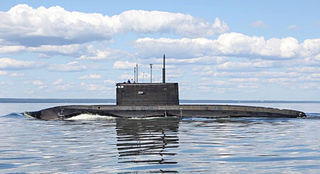
The Kilo-class submarines are a group of diesel-electric attack submarines designed by the Rubin Design Bureau in the Soviet Union in the 1970s and built originally for the Soviet Navy.
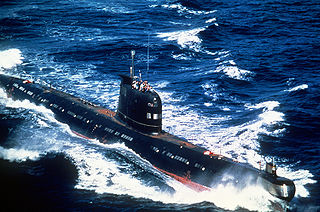
The Foxtrot class was the NATO reporting name of a class of diesel-electric patrol submarines that were built in the Soviet Union. The Soviet designation of this class was Project 641. The Foxtrot class was designed to replace the earlier Zulu class, which suffered from structural weaknesses and harmonic vibration problems that limited its operational depth and submerged speed. The first Foxtrot keel was laid down in 1957 and commissioned in 1958 and the last was completed in 1983. A total of 58 were built for the Soviet Navy at the Sudomekh division of the Admiralty Shipyard, Saint Petersburg. Additional hulls were built for other countries.
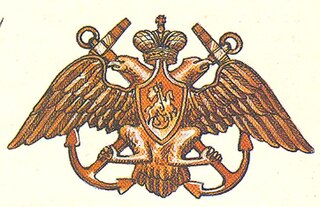
The Imperial Russian Navy operated as the navy of the Russian Tsardom and later the Russian Empire from 1696 to 1917. Formally established in 1696, it lasted until dissolved in the wake of the February Revolution of 1917. It developed from a smaller force that had existed prior to Tsar Peter the Great's founding of the modern Russian navy during the Second Azov campaign in 1696. It expanded in the second half of the 18th century and reached its peak strength by the early part of the 19th century, behind only the British and French fleets in terms of size.
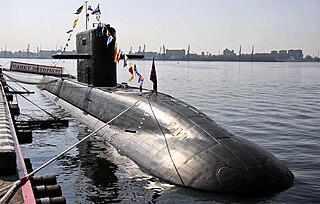
Lada class, Russian designation Project 677 Lada is the new advanced class of diesel-electric attack submarine designed by the Russian Rubin Design Bureau. A program to develop a "fourth generation" diesel-electric submarine, it aimed to produce a highly improved version of the Project 636 with better acoustic signature, new combat systems and possibly air-independent propulsion. However, in 2019, Alexander Buzakov, the head of the Admiralty Shipyard, indicated that there were no plans to equip the Lada class with an air-independent propulsion system. In July 2022 it was reported that work on an electrochemical generator to produce hydrogen from diesel fuel and oxygen was continuing and that the Rubin Central Design Bureau signed a new contract in 2019 to continue work. This was scheduled to be completed by the mid-2020s. In 2023, the decision was taken to decommission and scrap the lead ship of the class, the Sankt Peterburg due to the very high costs of modernising the submarine.

The Holland 602 type submarine, also known as the H-class submarine, was one of the most numerous submarines of World War I. The type was designed by the Electric Boat Co. of the United States, but most of the boats were built abroad: in Canada by the subsidiary of the British Vickers company and in British shipyards.
The Russian submarine AG-12 was an AG-class submarine, designed by the American Holland Torpedo Boat Company/Electric Boat Company, built for the Imperial Russian Navy during World War I. The submarine was fabricated in Canada, shipped to Russia and reassembled for service with the Baltic Fleet. She was scuttled by the Russians at Hanko in April 1918.

The AG-16 was an AG-class submarine, designed by the American Holland Torpedo Boat Company/Electric Boat Company, built for the Imperial Russian Navy during World War I. The submarine was fabricated in Canada, shipped to Russia and reassembled for service with the Baltic Fleet. The boat was originally named AG-13, but was redesignated AG-16 after AG-15 sank and later repaired in 1917. She was scuttled by the Russians at Hanko in April 1918.
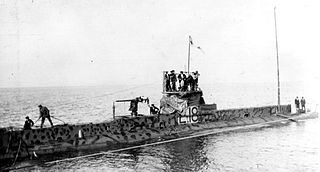
A British submarine flotilla operated in the Baltic Sea for three years during the First World War. The squadron of nine submarines was attached to the Russian Baltic Fleet. The main task of the flotilla was to prevent the import of iron ore from Sweden to Imperial Germany. The success of the flotilla also forced the German Navy in the Baltic to keep to their bases and denied the German High Seas Fleet a training ground. The flotilla was based in Reval (Tallinn), and for most of its career commanded by Captain Francis Cromie.

The Orfey-class destroyers were built for the Baltic Fleet of the Imperial Russian Navy. They were modified versions of the earlier destroyer Novik and the Derzky-class destroyers. These ships were larger, had triple torpedo tubes and an extra 102 mm (4 in) gun. One ship, Engels, was fitted with a 305 mm (12 in) recoilless rifle for testing in 1934. Fourteen ships were completed in 1914–1917 and fought in World War I and during the Allied intervention in the Russian Civil War. The survivors fought in World War II.

The American Holland-class submarines, also AG class or A class, were Holland 602 type submarines used by the Imperial Russian and Soviet Navies in the early 20th century. The small submarines participated in the World War I Baltic Sea and Black Sea theatres and a handful of them also saw action during World War II.

The Morzh-class submarines were built for the Black Sea Fleet of the Imperial Russian Navy shortly before World War I.
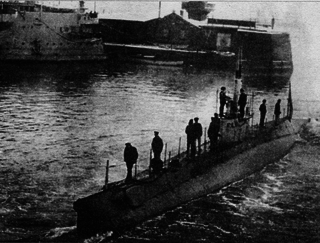
The Russian submarine AG-11 was an AG-class submarine, designed by the American Holland Torpedo Boat Company/Electric Boat Company, built for the Imperial Russian Navy during World War I. The submarine was fabricated in Canada, shipped to Russia and reassembled for service with the Baltic Fleet.

Gavriil was an Orfey-class destroyer of the Russian Imperial Navy. The destroyer was built by the Russo-Baltic Yard at Reval, launching on 5 January 1915 and completing in October 1916. She served with the Baltic Fleet during the remainder of the First World War, and after the October Revolution joined the Bolshevik Red Fleet. She was active during the Russian Civil War, taking part in several engagements against British ships during the British campaign in the Baltic, and was sunk by a mine on 21 October 1919.

Azard was one of eight Orfey-class destroyers built for the Russian Imperial Navy during World War I. Completed in 1916, she served with the Baltic Fleet and joined the Bolshevik Red Fleet after the October Revolution of 1918. She was active during the Russian Civil War, taking part in several engagements against British ships during the British campaign in the Baltic. The destroyer was renamed Zinoviev in 1922 and Artem in 1928. She remained in service with the Soviet Baltic Fleet when Germany invaded the Soviet Union in 1941, and was sunk by a mine on 28 August.
The K-391 Bratsk is an Akula-class submarine in the Russian Navy.

The Russian submarine Tyulen was the third and last boat in the Morzh class of submarines of the Imperial Russian Navy. It was laid down in August 1913 and was launched in November 1913, though it did not enter service until March 1915. Built for the Black Sea Fleet, it saw action during World War I and became the most successful Russian submarine in the Black Sea, credited with sinking over 40 ships for a total tonnage of 8,973 gross register tons (GRT). It was also the second most successful Russian submarine in the war overall, after Volk.

The Russian submarine Morzh was the lead ship of the Morzh class of submarines of the Imperial Russian Navy. The submarine was laid down in August 1913 and was launched in September 1913, though it was not completed until April 1915.

The Russian submarine Nerpa was the second boat of the Morzh-class of submarines of the Imperial Russian Navy. It was laid down and launched on the same day in August 1913, and completed its sea trials in December 1914. Built for the Black Sea Fleet, the submarine saw action during World War I, and spent much of the war raiding Ottoman merchant shipping that transported coal from Zonguldak to Constantinople. Nerpa was credited with sinking 24 ships during the conflict for a total of 2,443 gross register tons (GRT), making it the fourth most successful Russian submarine in the Black Sea.


















